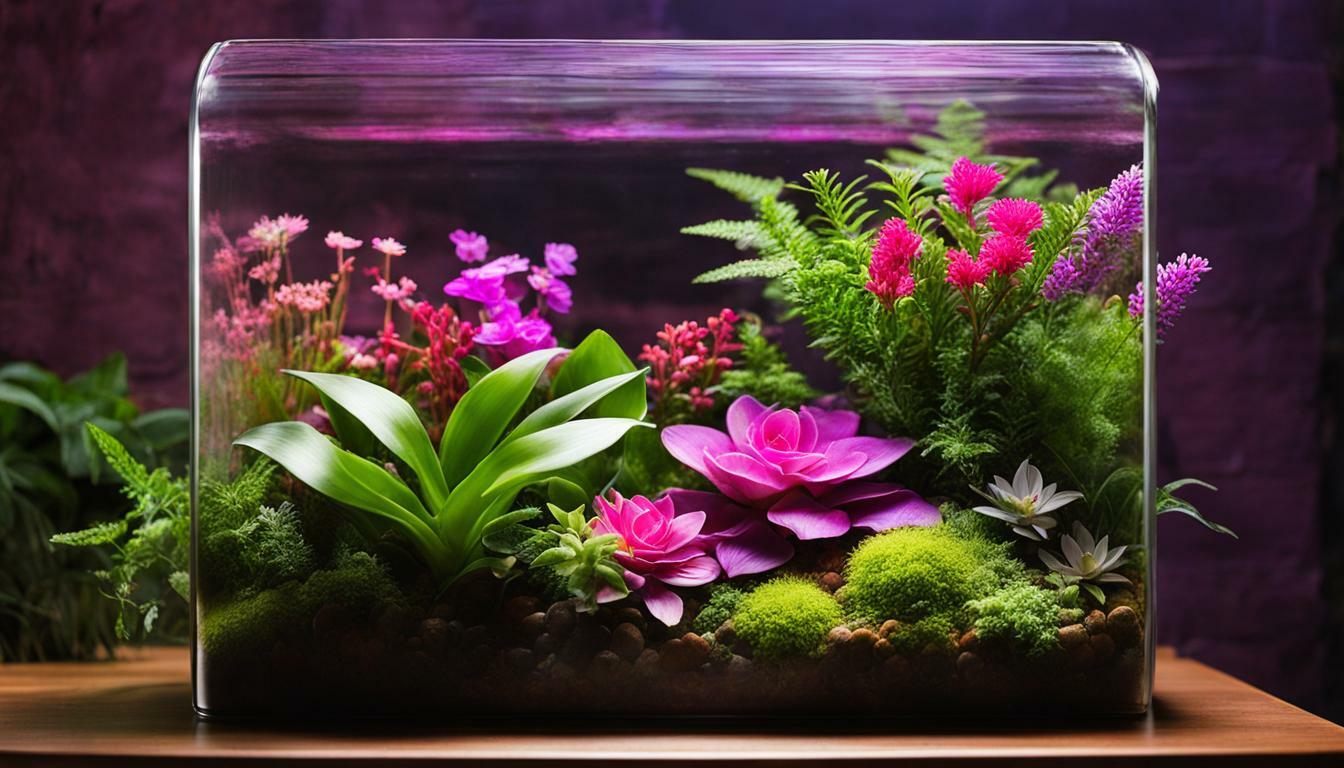Terrarium plants can add a touch of beauty and color to any indoor space, and in this guide, we will show you how to successfully grow and care for flowering plants in your terrarium. Whether you’re a beginner or an experienced gardener, this comprehensive guide will provide you with all the information you need to create a blooming indoor green space with your terrarium plants.
- Choose the right type of terrarium plants based on whether you have an open or closed terrarium.
- Popular terrarium plant options include ferns, foliage plants, vines, epiphytes, and moss.
- Flowering plants like Oxalis, Orchids, Begonias, and African Violets can also thrive in terrariums.
- Position your terrarium in the right location for optimal light.
- Proper watering, pruning, and addressing common issues are essential for the health of your terrarium plants.
With the tips and guidelines provided in this guide, you’ll be able to create a stunning indoor green space filled with vibrant and blooming terrarium plants.
Understanding Terrarium Plant Selection and Requirements
Selecting the right terrarium plants and understanding their requirements is the foundation for a successful flowering terrarium. Terrarium plants come in a variety of types, and it’s important to choose the right ones based on whether you have an open or closed terrarium. Closed terrarium plants are tropical species, while open terrarium plants are typically arid species.
Popular terrarium plant options include ferns, foliage plants like Peperomia and Calathea, vines like Selaginella and Syngonium, and epiphytes like Tillandsia Air Plants. These plants not only add beauty but also create a harmonious ecosystem within your terrarium. Additionally, moss can be a great addition for both open and closed terrariums, providing a lush and natural look.
For those who want to incorporate flowering plants in their terrariums, there are several options available. Oxalis, Orchids, Begonias, African Violets, and certain flowering terrarium plants are well-suited for these enclosed environments. These plants bring color and vibrancy to your terrarium, creating a captivating display.
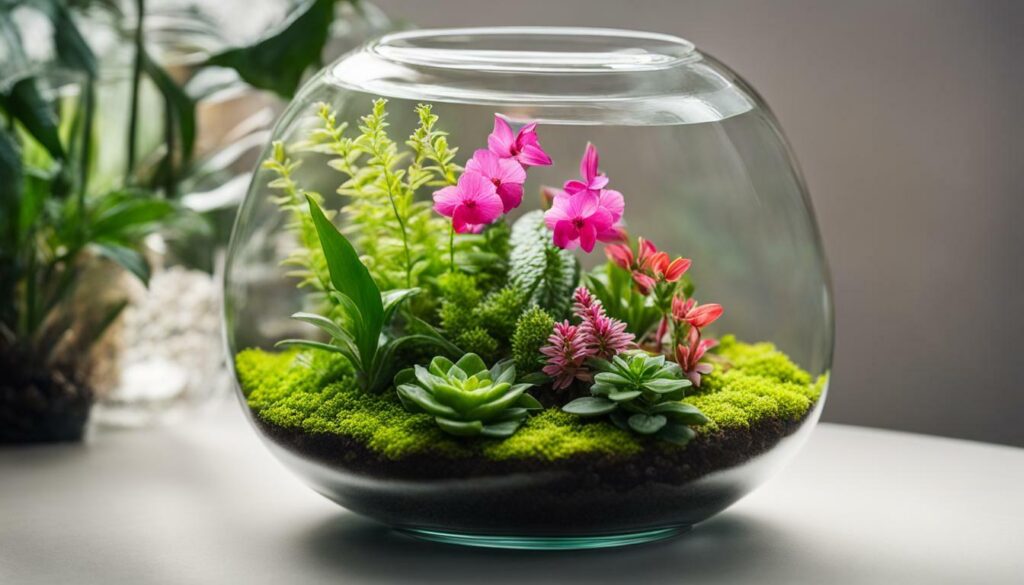
Once you have selected your terrarium plants, it’s important to understand their specific requirements. Different plants have different needs for light, water, and humidity. Some plants thrive in bright, indirect light, while others prefer low light conditions. It’s crucial to find the right balance to ensure the plants’ health and overall growth.
When it comes to watering, terrarium plants require careful attention. Overwatering can lead to root rot and other issues, while underwatering can cause wilting and stunted growth. It’s important to monitor the moisture levels and adjust your watering routine accordingly. Additionally, proper pruning and maintenance will help keep your plants in optimal condition, promoting healthy growth.
Terrarium Plant Selection and Requirements – Summary:
- Select the right terrarium plants based on whether you have an open or closed terrarium.
- Popular options include ferns, foliage plants, vines, epiphytes, and moss.
- Consider incorporating flowering plants like Oxalis, Orchids, Begonias, and African Violets.
- Understand the specific light, water, and humidity requirements of your chosen plants.
- Regular pruning and maintenance are essential for optimal plant health.
Terrarium Plant Selection and Requirements – Table:
| Terrarium Plant Type | Light Requirements | Watering Needs | Humidity Preference |
|---|---|---|---|
| Ferns | Indirect light | Moist but not waterlogged | High humidity |
| Foliage plants | Varies (some prefer bright indirect light, others thrive in low light) | Varies (moderate watering) | Varies (moderate to high humidity) |
| Vines | Bright indirect light | Moist but not waterlogged | High humidity |
| Epiphytes | Indirect light | Varies (allow to dry slightly between watering) | Varies (moderate to high humidity) |
| Moss | Low light to bright indirect light | Varies (keep evenly moist) | Varies (moderate to high humidity) |
By carefully selecting the right terrarium plants and understanding their specific requirements, you can create a thriving and visually stunning flowering terrarium. Enjoy the beauty of nature within the confines of your own home, and experience the joy of nurturing these fascinating plants.
Popular Terrarium Plant Options for Flowering
Discover the beauty of popular flowering plants that are perfect for your terrarium. Terrarium plants come in a variety of types, and it’s important to choose the right ones based on whether you have an open or closed terrarium. Closed terrarium plants are tropical species, while open terrarium plants are typically arid species. Some popular terrarium plant options include:
- Ferns: Known for their lush foliage, ferns are an excellent choice for adding a touch of greenery to your terrarium. They thrive in medium to bright indirect light and require regular misting to maintain humidity.
- Foliage Plants: Peperomia and Calathea are popular foliage plants that offer a variety of colors and patterns. These plants do well in medium to low light conditions and require watering when the top inch of soil becomes dry.
- Vines: Selaginella and Syngonium are trailing vines that add a cascading effect to your terrarium. They prefer bright indirect light and high humidity, making them ideal for closed terrariums.
- Epiphytes: Tillandsia Air Plants are unique terrarium plants that don’t require soil. They can be attached to driftwood or rocks and thrive in bright indirect light. These plants require misting or soaking in water once a week.
- Moss: Moss is a versatile terrarium plant that can be used as a ground cover or to create a lush green backdrop. It thrives in low to medium light and requires regular misting to keep it moist.
“Flowering plants can also be included in terrariums, adding a splash of color to your green oasis. Consider incorporating Oxalis, Orchids, Begonias, African Violets, and other suitable options to create a visually stunning terrarium.”
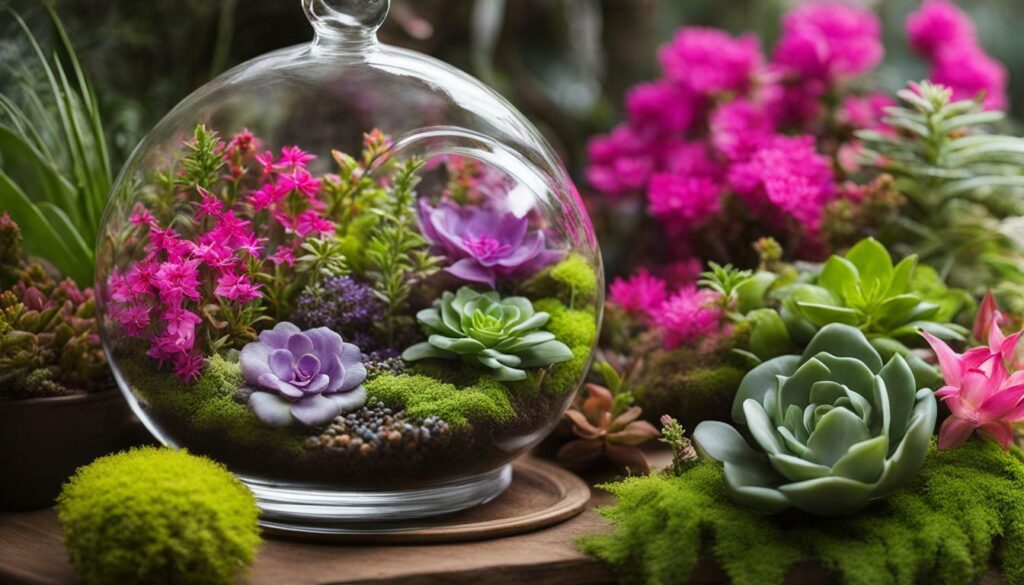
When caring for a terrarium, it’s important to position it in the right location for light and provide the necessary care for the plants to thrive. Ensure your flowering terrarium plants receive the appropriate amount of light, whether it’s bright indirect light for ferns and foliage plants, or medium to low light for certain orchids and begonias.
Watering is also crucial for the health of your terrarium plants. Each type of plant has specific watering needs, and it’s important to strike the right balance between hydration and avoiding overwatering. Regularly check the moisture levels of the soil or moss to determine when to water.
Pruning is necessary to maintain the shape and health of your terrarium plants. Trim any dead or yellowing leaves, as well as any overgrown vines or plants that are encroaching on other species. This will promote healthy growth and prevent overcrowding.
Summary:
Popular flowering plants such as ferns, foliage plants, vines, epiphytes, and moss can thrive in terrariums, adding beauty to your indoor green space. Consider incorporating Oxalis, Orchids, Begonias, African Violets, and other suitable options for a visually stunning terrarium display. Position your terrarium in the right location for light and provide proper care, including watering and pruning, to ensure your plants flourish.
Terrarium Plant Care and Maintenance Tips
To ensure the longevity and health of your flowering terrarium plants, follow these care and maintenance tips. Terrarium plants come in a variety of types, so it’s important to choose the right ones based on whether you have an open or closed terrarium. Closed terrarium plants are tropical species, while open terrarium plants are typically arid species. Some popular terrarium plant options include ferns, foliage plants like Peperomia and Calathea, vines like Selaginella and Syngonium, epiphytes like Tillandsia Air Plants, and moss. It’s also possible to include flowering plants in terrariums, such as Oxalis, Orchids, Begonias, African Violets, and certain flowering terrarium plants.
When caring for a terrarium, proper positioning is crucial. Place your terrarium in a location that receives adequate light but is protected from direct sunlight. Most terrarium plants prefer bright, indirect light. If your plants start to look leggy or pale, they may be receiving too little light, and if they become scorched or start to yellow, they may be getting too much.
Watering your flowering terrarium plants correctly is key to their overall health. The specific watering needs of your plants will depend on the types you have chosen and the size of your terrarium. Before watering, always check the moisture level of the soil using your finger or a moisture meter. You want to keep the soil slightly moist but not waterlogged. Overwatering can lead to root rot, while underwatering can cause your plants to wither and die.
Regular pruning and general maintenance are essential for the overall health and appearance of your flowering terrarium plants. Remove any dead or yellowing leaves, as well as any overgrown or damaged parts. This will promote healthy growth and prevent disease or pest infestations. Additionally, keep an eye out for any signs of pests or diseases, such as spider mites or fungal infections. If detected, take immediate action to address the issue and protect your plants.
| Plant Type | Light Requirements | Watering Needs |
|---|---|---|
| Ferns | Indirect light | Moist, but not waterlogged |
| Peperomia | Moderate to bright indirect light | Allow soil to dry between waterings |
| Calathea | Medium to bright indirect light | Keep soil consistently moist |
| Selaginella | Indirect light | Moderate watering |
| Syngonium | Medium to bright indirect light | Allow soil to dry partially between waterings |
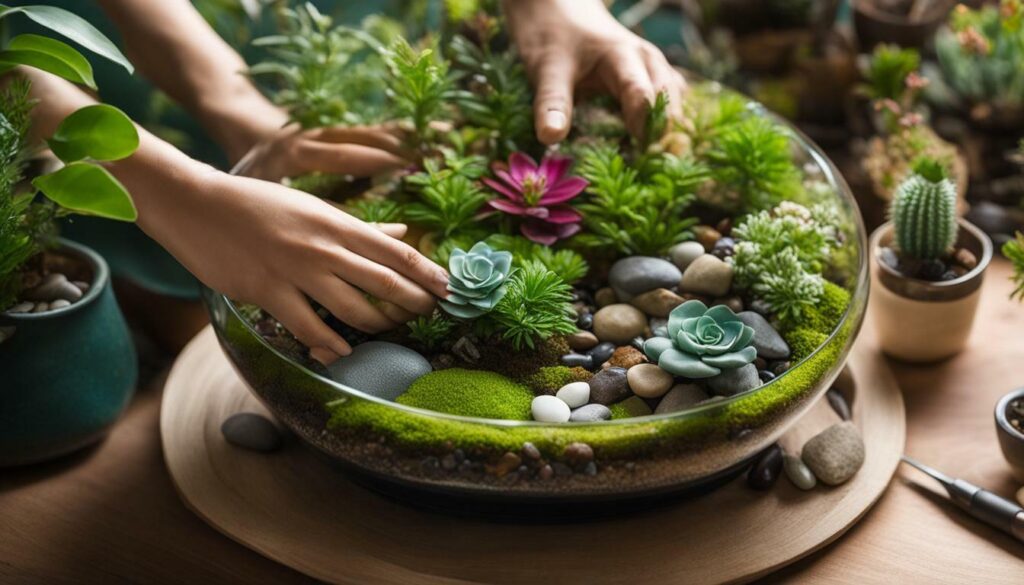
“Proper care and maintenance are essential for the health and longevity of your flowering terrarium plants. By selecting the right plants, providing adequate light, watering appropriately, and practicing regular maintenance, you can create a thriving indoor green space that brings color and beauty to your home or office.” – Gardening Expert
Positioning Your Terrarium for Optimal Growth
Understanding the importance of proper positioning will help your flowering terrarium plants thrive. The placement of your terrarium plays a crucial role in its overall growth and development. When positioning your terrarium, consider the lighting requirements of your plants and create the perfect environment for them to flourish.
For flowering terrarium plants, it’s important to provide adequate sunlight. Place your terrarium near a window or in a spot where it can receive bright, indirect light. Avoid placing it in direct sunlight as this can potentially scorch the leaves and cause damage to your plants.
If you are unable to provide enough natural light, you can supplement it with artificial light sources like grow lights. LED grow lights are a popular option as they provide the necessary light spectrum for plant growth without generating excessive heat.
| Positioning Tips for Optimal Growth |
|---|
| Place your terrarium near a window with bright, indirect light. |
| Avoid placing your terrarium in direct sunlight to prevent leaf scorching. |
| If natural light is insufficient, use LED grow lights to supplement the light spectrum. |
In addition to light, consider the temperature and humidity levels in the area where you position your terrarium. Most terrarium plants thrive in temperatures between 60°F and 75°F (15°C to 24°C) with moderate humidity. Avoid placing your terrarium near drafts or in areas with fluctuating temperatures.
By following these positioning tips, you can create an ideal environment for your flowering terrarium plants and ensure optimal growth. Remember to monitor and adjust the position as needed based on the specific requirements of your plants. Happy gardening!
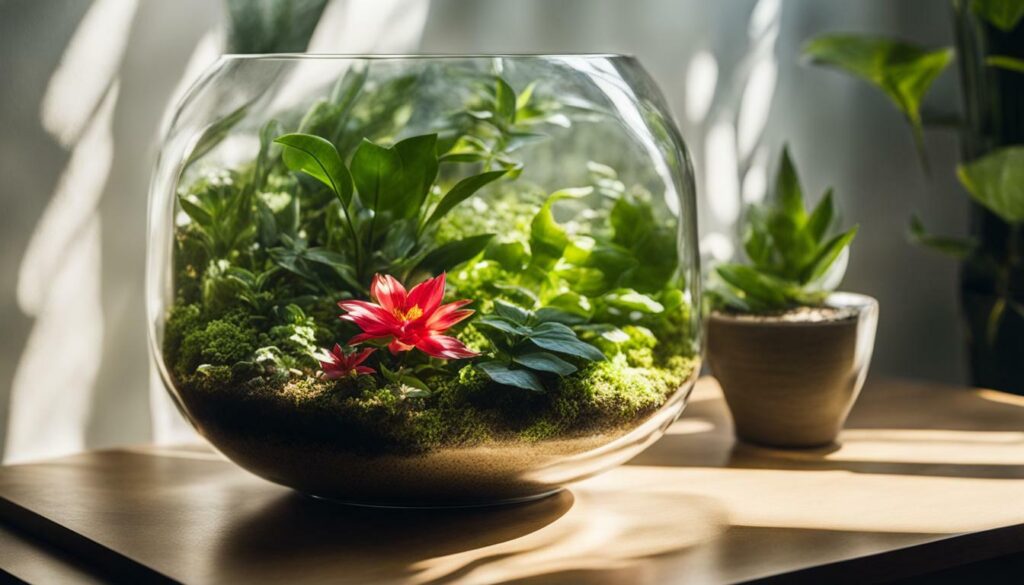
Achieving the proper watering and hydration balance is crucial for the success of your flowering terrarium. Overwatering can lead to root rot and other issues, while underwatering can cause wilting and stunted growth. To ensure your plants thrive, follow these tips on watering and maintaining proper hydration levels.
Firstly, it’s important to understand the specific watering needs of your terrarium plants. Different species have varying requirements, so research and familiarize yourself with each plant’s preferences. Tropical flowering plants, for example, may require more frequent watering compared to arid species.
A good way to assess when your plants need watering is to feel the top inch of soil. If it feels dry, it’s time to water. Use a watering can or spray bottle to hydrate the soil evenly, ensuring that the water reaches the plant’s roots. Avoid overwatering by allowing excess water to drain out through the terrarium’s drainage holes, if applicable.
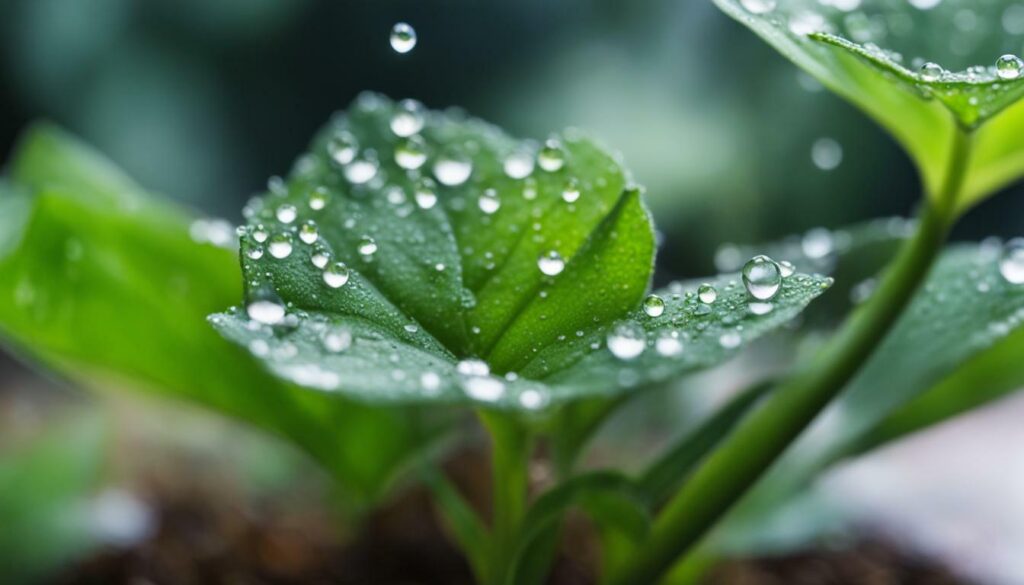
Keep in mind that terrariums create a humid environment, which may affect the watering needs of your plants. Monitor the moisture level within your terrarium and adjust your watering schedule accordingly. If you notice excessive condensation on the sides of the terrarium, it may indicate high humidity, and you might need to reduce watering frequency.
Maintaining Proper Hydration
In addition to watering, maintaining proper hydration levels within your terrarium is essential. Since terrariums have limited airflow, it’s crucial to strike a balance between providing enough moisture and preventing excessive dampness. Use a spray bottle to mist the foliage of your flowering terrarium plants regularly, promoting hydration without saturating the soil.
Regularly check the soil moisture to ensure it’s not overly wet or dry. Adjust the frequency of misting based on the plant’s needs and the overall humidity within the terrarium. As a general rule, it’s better to slightly under-mist and monitor plant response rather than over-mist and risk waterlogged soil conditions.
By understanding and meeting the watering and hydration needs of your flowering terrarium plants, you can create a thriving and visually appealing indoor green space. Remember to consider each plant’s unique requirements, and closely monitor the moisture levels to maintain optimal conditions for growth.
Pruning and Maintenance for Healthy Flowering Terrariums
Pruning and maintenance are key factors in maintaining beautiful and healthy flowering terrariums. Regular pruning helps control the growth of your terrarium plants and encourages bushier and fuller foliage. It also helps remove any dead or damaged leaves, ensuring that your plants stay vibrant and free from disease.
When it comes to pruning, it’s essential to use the right tools. A pair of sharp, clean scissors or garden shears will do the job. Before you begin, take a careful look at your plants and identify any areas that need attention. Trim away any yellow or brown leaves, making sure to cut close to the stem without damaging it. If you notice any overgrown branches or vines, gently prune them back to maintain the desired shape and size of your terrarium.
In addition to pruning, regular maintenance is crucial for the overall health of your flowering terrarium. This includes regularly checking the moisture levels of the soil and adjusting your watering schedule accordingly. Overwatering can lead to root rot and other issues, so it’s essential to strike the right balance. A helpful tip is to insert a wooden skewer into the soil. If it comes out dry or with minimal moisture, it’s time to water your plants.
Another important aspect of maintenance is monitoring for any signs of pests or disease. Inspect your terrarium regularly for common culprits like aphids, mealybugs, or spider mites. If you spot any pests, gently wipe them away with a cloth or use an organic insecticidal soap to control the infestation. Additionally, keep an eye out for any signs of plant diseases like fungal growth or discoloration, and take immediate action to prevent it from spreading.
| Pruning and Maintenance Tips: |
|---|
| 1. Use sharp, clean scissors or garden shears for pruning. |
| 2. Remove dead or damaged leaves regularly. |
| 3. Trim overgrown branches or vines to maintain desired shape. |
| 4. Check soil moisture levels before watering. |
| 5. Monitor for pests and disease regularly. |
| 6. Wipe away pests or use organic insecticidal soap. |
| 7. Take immediate action against plant diseases. |
By implementing proper pruning and maintenance techniques, you can ensure that your flowering terrarium plants thrive and continue to beautify your indoor space. Remember, each plant may have specific care requirements, so it’s essential to research and understand the needs of your chosen terrarium plants to provide the best care possible.
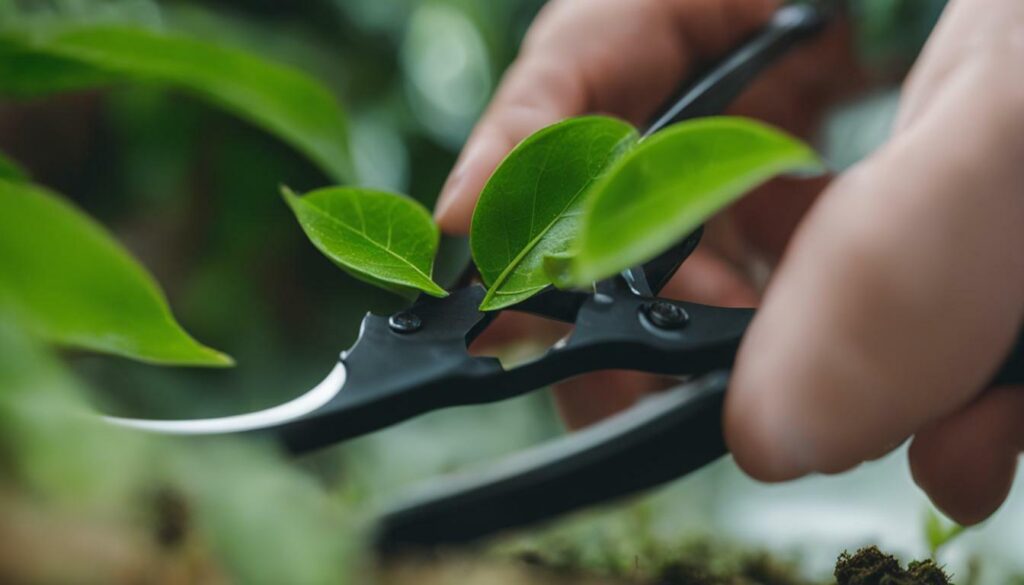
When pruning, always make clean cuts at a slight angle. This helps the wounds heal faster and prevents water from pooling on the cut surface, reducing the risk of disease. Additionally, maintain good hygiene by disinfecting your pruning tools between plants to avoid spreading any potential pathogens.
Dealing with Common Issues in Flowering Terrariums
Learn how to identify and address common issues that may affect the health of your flowering terrarium plants. Terrarium plants, like any other plants, can encounter various problems that can hinder their growth and vitality. By understanding these issues and taking prompt action, you can ensure the well-being of your beautiful indoor green space.
1. Pest Infestations:
One of the most common problems in flowering terrariums is pest infestation. Insects, such as aphids, mealybugs, and spider mites, can wreak havoc on your plants. To combat these pesky invaders, you can use organic insecticidal soap or neem oil. Apply the solution according to the product instructions, ensuring thorough coverage of the affected plants. Regularly inspect your terrarium for signs of pests and take immediate action to prevent further damage.
2. Fungal Diseases:
Fungal diseases like powdery mildew or root rot can occur in terrariums due to excess moisture and poor air circulation. To prevent these diseases, ensure proper spacing between plants and avoid overwatering. If you notice signs of fungal growth, remove the affected leaves or plants immediately. Improve ventilation by opening the terrarium lid periodically to allow fresh air circulation. Alternatively, you can use a fan to create gentle air movement around the plants.
3. Nutrient Deficiencies:
Flowering terrarium plants require an adequate supply of nutrients to thrive. Lack of essential nutrients can lead to stunted growth, yellowing leaves, or poor flowering. To address nutrient deficiencies, consider using a balanced liquid fertilizer specifically formulated for terrarium plants. Follow the instructions provided by the manufacturer for the correct application frequency and dosage. Regularly monitor the condition of your plants and adjust the fertilization routine as needed.
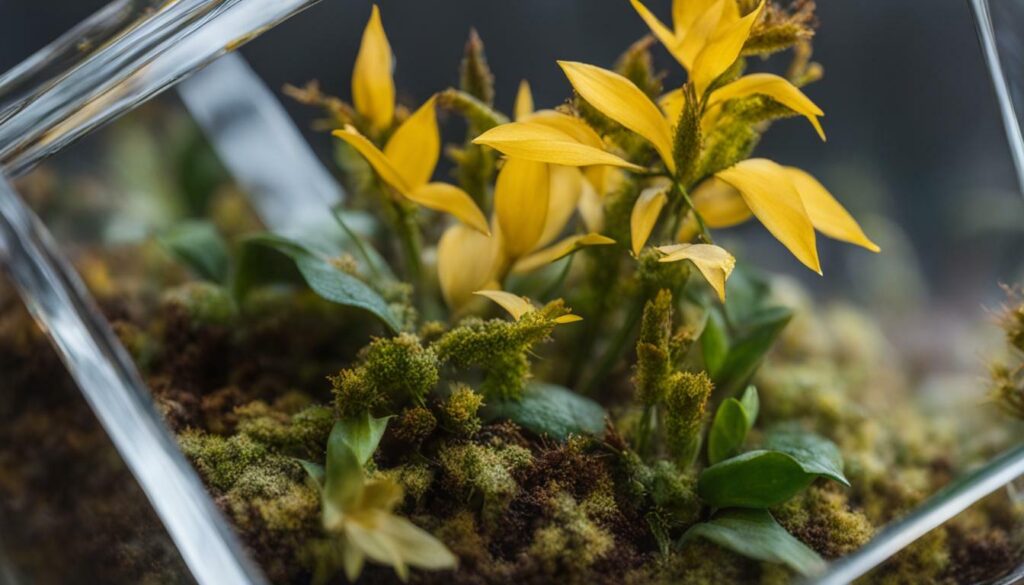
Remember, prevention is key to maintaining the health of your flowering terrarium plants. Regularly inspecting your plants, providing appropriate care, and addressing any issues promptly will help ensure a thriving and vibrant indoor green space.
Conclusion
With the knowledge gained from this guide, you are well equipped to grow and care for flowering terrarium plants, bringing beauty and life to your indoor environment. Terrarium plants come in a variety of types, and it’s important to choose the right ones based on whether you have an open or closed terrarium. Closed terrarium plants are tropical species, while open terrarium plants are typically arid species.
Some popular terrarium plant options include ferns, foliage plants like Peperomia and Calathea, vines like Selaginella and Syngonium, epiphytes like Tillandsia Air Plants, and moss. It’s also possible to include flowering plants in terrariums, such as Oxalis, Orchids, Begonias, African Violets, and certain flowering terrarium plants.
When caring for a terrarium, it’s important to position it in the right location for light, water the plants appropriately, prune them as needed, and address any issues such as excess water or mold. By following these guidelines, you can create a thriving and visually appealing indoor green space filled with vibrant and blooming plants.
How do I Care for Flowering Plants in a Terrarium Like I Would Pothos?
When it comes to lush terrarium plant care, providing proper conditions is key. Just like caring for Pothos, flowering plants in a terrarium require the right amount of light, water, and nutrients. Place your terrarium in a spot with indirect sunlight, water sparingly to avoid excess moisture, and use a balanced fertilizer to nourish the plants. Remember to monitor the temperature and humidity levels as well, as they play a crucial role in the well-being of your flowering plants.
FAQ
What types of plants are suitable for terrariums?
Terrarium plants can vary depending on whether you have an open or closed terrarium. Closed terrariums typically house tropical species, while open terrariums are ideal for arid plants. Popular options include ferns, foliage plants like Peperomia and Calathea, vines like Selaginella and Syngonium, epiphytes like Tillandsia Air Plants, and moss.
Can I include flowering plants in my terrarium?
Yes, it is possible to include flowering plants in terrariums. Some suitable options for flowering terrariums include Oxalis, Orchids, Begonias, African Violets, and certain flowering terrarium plants. These plants can add a burst of color and beauty to your indoor green space.
How should I care for my terrarium plants?
Caring for terrarium plants involves positioning them in the right location for light, watering them appropriately, pruning as needed, and addressing any issues such as excess water or mold. It’s important to provide the specific care requirements of each plant species to ensure their health and growth.
Where should I place my terrarium for optimal growth?
The placement of your terrarium is crucial for the growth and development of your plants. It’s important to consider the lighting requirements of the specific plant species you have. Generally, providing indirect or filtered light is ideal for most terrarium plants. Placing your terrarium near a window with bright, indirect light is often recommended.
How often should I water my terrarium plants?
The watering needs of terrarium plants can vary depending on the specific plant species and the type of terrarium you have. It’s important to strike the right balance between hydration and avoiding overwatering. Monitor the moisture levels in the soil and adjust watering accordingly. It’s generally better to underwater than to overwater your terrarium plants.
Do I need to prune my terrarium plants?
Pruning is an essential part of maintaining healthy terrarium plants. It helps promote growth, remove dead or yellowing foliage, and maintain the overall shape and appearance of your plants. Regularly check for any signs of overgrowth or pests and prune as needed to keep your terrarium plants in optimal condition.
What should I do if I encounter common issues in my terrarium?
Common issues in terrariums can include pests, diseases, and nutrient deficiencies. If you notice any signs of problems, such as yellowing leaves, wilting, or discoloration, it’s important to address them promptly. Depending on the specific issue, treatments can include adjusting watering, removing affected foliage, or using natural pest control methods.

